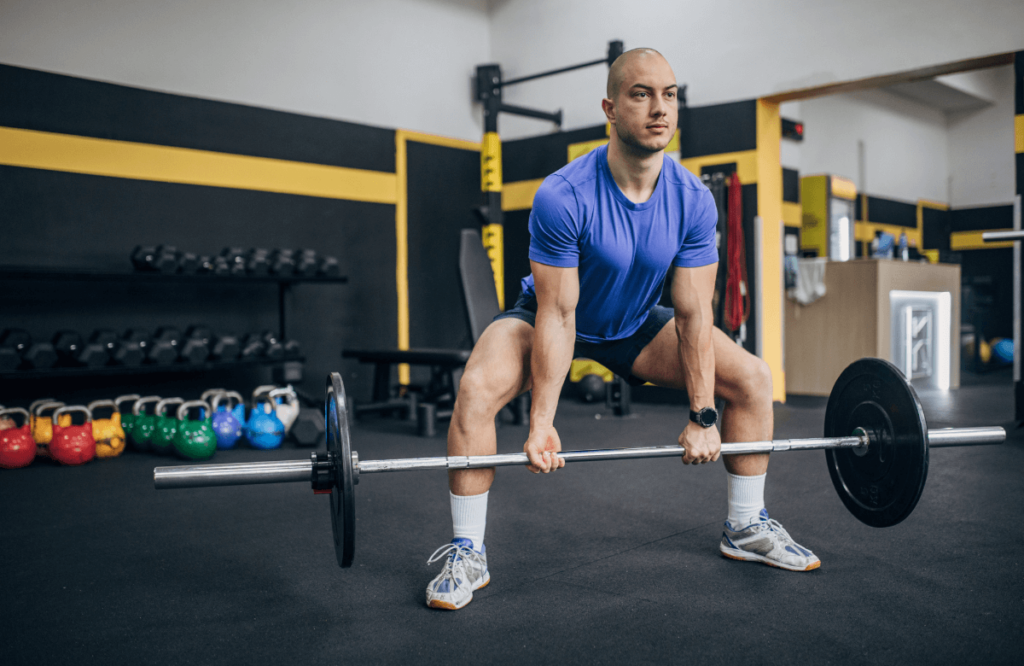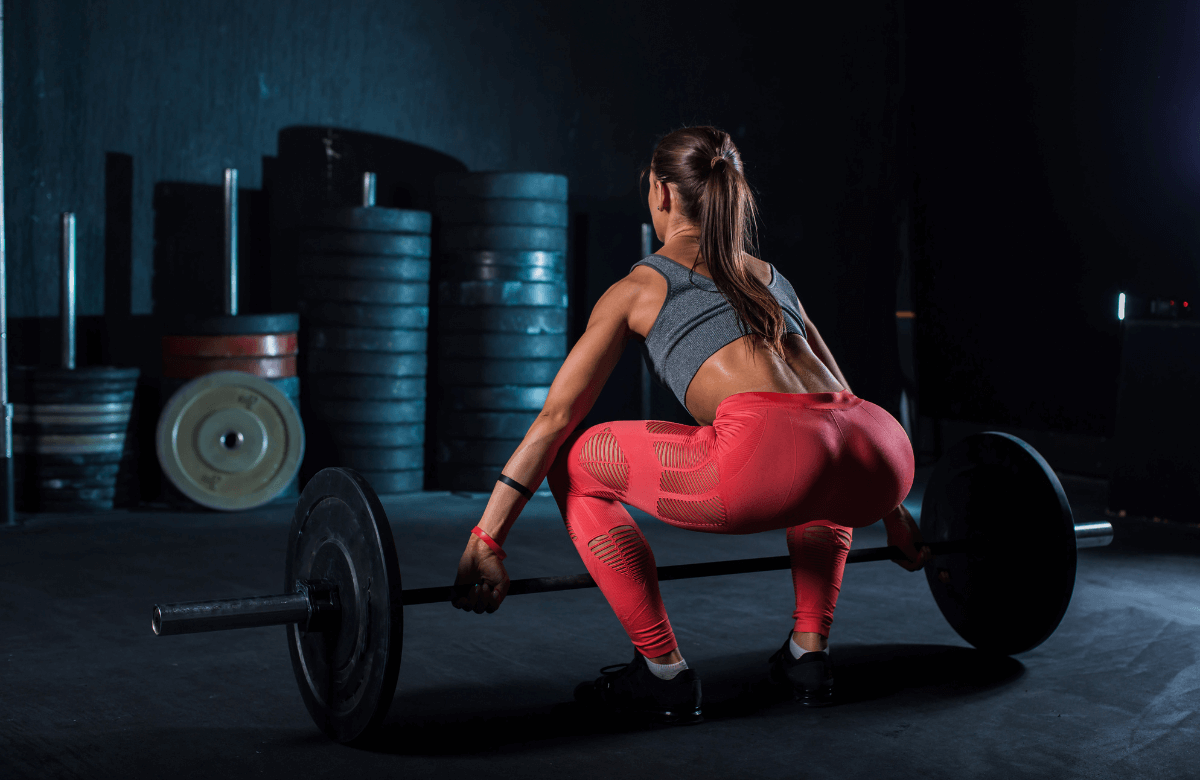Theoretically, every movement that involves hip extension is working your glutes. However, not all of them provide enough tension to yield the results you might be looking for.
To help you on that quest, we’ll teach you the 8 best deadlifts for glutes to get the perfect butt.
- Deficit deadlift
- Tempo deadlift
- Sumo deadlift
- Single-leg deadlift
- Romanian deadlift
- Landmine deadlift
- Bulgarian deadlift
- Split Stance Romanian deadlift
You’ll also learn about the anatomy of the glutes, and we’ll leave a workout ready for you to try and skyrocket your glute growth.
Buckle up!
Jump to:
What Is A Deadlift?
The deadlift is a hip-dominant movement that takes the bar from the floor in a half-squat position upwards until the hips and knees are fully extended.
This exercise is usually done with an Olympic barbell, but you can also use a trap bar (hex bar), dumbbells, or kettlebells. Independent of the variation, the movement pattern is the same.
Deadlifts are an effective exercise to push the glutes into growth mode. On top of that, they will also work your entire posterior chain, including lats, traps, hamstrings, and spinal erectors.
That versatility makes the deadlift a compound exercise with almost zero downsides.
The Anatomy Of Glutes
The gluteal muscles are a 3-muscle group consisting of:
1. Gluteus maximus

2. Gluteus minimus

3. Gluteus medius

These hip muscles make for most of the buttock area. They are defined at the top by the iliac crest and the gluteal fold at the bottom.
The gluteus maximus, the largest of the three, has a quadrangular shape and plays a crucial role in maintaining the upper body in an erect posture and extending and externally rotating the thigh (1).
The gluteus minimus and medius are underneath the gluteus maximus. Both work together as hip abductors and are vital for keeping normal locomotion (2).
These three gluteal muscles extend the hips, rotating and abducting the femur. Although they don’t do this alone, they are the primary movers.
Top 8 Best Deadlifts For Glutes To Try
There are many ways to make your glutes grow, especially with deadlifts. The reason why this movement is fantastic for developing strong glutes is because of their versatility.
When you hinge on the deadlifts, your glute muscles extend the hip until complete lockout.
1. Deficit Deadlift
The deficit deadlift gets its name from having the starting position on top of an elevated surface, increasing the range of motion. For that reason, this is considered an advanced lift.
A greater range of motion pushes the body to recruit more muscle fibers and meet the exercise demands.
The deficit deadlift is not a heavy-weight variation (even for advanced lifters). Regardless, it’s a terrific option for people looking to take their glute training to the next level.
You can do between 10-15 reps for 2-3 sets. Make sure to have enough rest to keep your spine in check.
2. Tempo Deadlift
The tempo for any movement refers to the time spent on every portion of the lift. It’s measured in four digits, i.e., “3001”.
The first “0” refers to the time spent at the bottom. The second “0” means the time spent on the positive or concentric (going up). The “3” represents the seconds spent in the negative or eccentric portion (going down). And the “1” equals the seconds on holding the top.
A prescribed tempo will put the working muscles through a prolonged time under tension (TUT), creating more stress and muscle gains in your glutes.
Tempo deadlifts are also an excellent exercise to reinforce a proper technique and reduce injury risk. You can add them at the end of your deadlift session and keep the weight light.
3. Sumo Deadlift
Sumo deadlifts take their name from the fighting stance taken by the sumo wrestlers. The starting position uses a wider stance than conventional style deadlifts on this variation.
On the sumo stance, feet are slightly wider than hip-width, and the torso holds a more upright position. These qualities give the sumo a shorter range of motion and the ability to lift more weight.
However, you might need more hip external rotation to get the most benefits out of this variation. Nevertheless, the glutes and adductors activation in sumo deadlifts is almost unparalleled.
You can include it 1-2 times per week on the 8-12 rep range with slightly heavier weights than a conventional deadlift.
4. Single Leg Deadlift
The single leg is a challenging deadlift variation that targets your glutes and puts your balance to the test.
Although the body weight variation can be enough for many people, more advanced lifters feel comfortable using a barbell, dumbbells, or kettlebells.
If you’ve never done this movement, we recommend using a stick to help with your balance and keep it body weight until you can add weight and feel the exercise on your glute.
You can include this variation at the beginning of your session as a warm-up or add it at the end as a finisher. Either way, you’ll find this a challenging lift that fits perfectly into your training goals.
5. Romanian Deadlift
The Romanian deadlifts (RDL) are one of the most performed for glute growth. Their main characteristic is the ample range of motion, which produces more muscle recruitment and lean mass production.
In this variation, the barbell never touches the floor throughout the rep range, and the knees are slightly bent. This also increases the time under tension on the primary muscles, contrary to traditional deadlifts, which get a few seconds of “rest” every time they hit the floor.
You can do RDLs with a barbell, dumbbells, or kettlebells. Whichever form you do, expect your posterior chain muscles to be sore the following day.
6. Landmine Deadlift
The landmine deadlift is a variation that requires a barbell attached to a landmine. The movement pattern is the same. However, you can yield more benefits if you focus on single-leg variations with the landmine.
It’s hard to use both hands in this exercise, which can be an inconvenience if you’re looking to add heavier weights. Regardless, the landmine offers an excellent alternative for beginners.
It’s easier than the single-leg deadlift because holding the bar can help balance and stability. You can add this variation at the middle or the end of your deadlift session with 2-3 sets of 8-12 reps at a challenging yet manageable weight.
7. Bulgarian Deadlift
If you thought Bulgarian split squats were great for your legs, wait until you try the Bulgarian deadlift. Stand in front of the bench, place one foot over it, and proceed with the deadlift. The body positioning is the same as the split squat.
This variation is usually performed with dumbbells or kettlebells, and it’s one of the popular options for growing the glutes.
Intermediate and advanced lifters typically go heavy on this movement, and even if you use lighter weights, the Bulgarian deadlift remains challenging.
On top of increasing your glute strength, it will also reveal any unilateral imbalances between your legs. You can pair it with other single-leg exercises like one-legged glute bridge or leg curls to get the most out of this variation.
8. Split Stance Romanian Deadlift
The split-stance Romanian deadlift is a modification of the conventional Romanian deadlift. The only difference is the awkward starting position.
The split stance variation will put more stress on the front leg muscles. It’s an excellent way to add more load on one leg compared to the other while still keeping a balanced position.
This variation is critical for revealing strength imbalances and increasing the muscle activation on the front leg glute muscles. You’ll feel the burn after a few sets of 8-12 reps, even if you’re a competitive powerlifter or a professional bodybuilder.
Avoid These Mistakes And Maximize Results
The deadlift is a challenging exercise by itself. To give yourself the most chances of achieving your goals and maximizing your results, stay away from the following mistakes!
1. Not Eating Enough Protein
Protein is an essential macronutrient when it comes to building muscle. It’s common to see many individuals work hard at the gym but need to pay more attention to their nutrition and protein intake, leaving them with subpar gains.
Ideally, you want to ingest around 0.8-1.2 grams per pound. This should be enough to enjoy the benefits of a balanced diet.
Although carbohydrates and fat play a crucial role in your body composition, protein intake takes the lead when it comes to keeping your muscles fresh and ready to crush the next deadlift session.
2. Not Increasing The Training Load
In strength training, there’s a principle called “progressive overload.” To avoid a plateau (stagnation) in your growth, you should increase the weight load steadily and weekly.
Failing to do this will limit your muscle and strength gains, leaving you short of the results you’re looking for.
To avoid this, some people use a training journal to write down the movement and load used to surpass that volume in the next session.

3. Poor Technique
When maximizing your results on deadlift training, you can only go as far as your technique allows. The deadlift is not a difficult movement to learn, but it does have crucial aspects to master.
Technique deficiencies like a rounded back, looking up, knees caving in, and not locking your hips at the top are common. However, if not addressed, they can increase the risk of injuries and keep you away from your goals.
Before increasing the load on the deadlifts, master the basic principles of form and technique to maximize your results.
Workout Sample For Building Glutes
Now that you have learned new information about the glutes and how the deadlift can help you build mass and strength. We compiled a glute workout for you to try at your convenience.
The workout is meant to be a guide, and you should approach it with flexibility. If you can’t do one of the movements, try looking for a variation that suits your current fitness level, and go from there.
Let us begin!
A1) Romanian Deadlift
A2) DB Deadlift
A3) DB Glute Bridge
Do between 3-4 sets, 8-12 reps at a manageable yet challenging weight. Make sure to rest for 2-3 minutes after each set.
B1) Sumo Deadlift
B2) Goblet Squat
B3) Frog Pumps
Try 2-3 sets, 10-15 reps at a lighter weight than the A block. Keep rest between 1-2 minutes after set.
C1) Single Leg Deadlift
C2) Box Step Ups
C3) Alternating Reverse Lunges
Aim for 1-2 sets, 6-10 reps, at a manageable weight. The muscles will be already tired by then, so you won’t need that huge volume.
Before starting, warm up properly and take care of your pre-workout meals, so your muscles are ready to crush it.

FAQ
Which Type Of Deadlift Is Best For the Glutes?
All deadlifts are great for your glutes. But variations like the sumo, Romanian, deficit, and single-leg deadlift are some of the best options. This is due to their higher muscle recruitment and convenient range of motion.
Can You Grow Glutes With Deadlifts?
Yes, you can grow glutes with deadlifts. The deadlifts are hip-dominant movements that make the glutes and hamstrings the primary muscles involved in extending the hips. Technically any deadlift variation will increase your glute muscle growth.
How Do You Target Glutes During Deadlifts?
The best way to target the glutes during deadlifts is by increasing the range of motion, focusing on a big and slow hip hinge, followed by a powerful hip extension, where most of the magic happens. The combination of hip flexion and extension will eventually push your glute muscles to grow.















